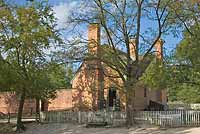Page content
Public Gaol

- General Assembly ordered prison built in Williamsburg when town became colony's capital
- Henry Cary named contractor to build gaol
- Debtors' cell added later
- Peter Pelham most famous gaoler
- Building restored in 1936
Construction authorized by general assembly in August 1701
Virginia's general assembly ordered a "substanciall brick prison" built in Williamsburg soon after it decided to make the city the colony's new capital. Known as the Public Gaol, the building's construction was authorized by an act of August 1701. Contractor Henry Cary got the job – as he had the Capitol and would the Governor's Palace. He had two cells ready in a building just north of the Capitol on Nicholson Street by May 1704.
The word gaol is pronounced "jail." It comes from an Old North French word, "gaole," which in turn comes from "caveola," a diminutive form of the Latin term "cavea," which means "cage." Debtors, runaway slaves – and occasionally the mentally ill – were sometimes confined in the Gaol. During the Revolution, tories, spies, military prisoners, deserters, and traitors were included in the prisoner inventory.
Most occupants awaiting trial in Court of Oyer and Terminer
Most occupants, however, were men and women awaiting trial in the General Court and the Court of Oyer and Terminer or convicts waiting to be branded, whipped, or hanged, according to their sentences. Though sentences were harsh by modern standards, first offenders might expect mercy, and some miscreants were merely fined. In any event, the Gaol was not intended for long-term imprisonment.
Gaol housed infamous prisoners
The Public Gaol's most celebrated occupants were 15 henchmen of the pirate Blackbeard, caught in 1718, and the infamous Henry "Hair Buyer" Hamilton, lieutenant governor of British Detroit, captured in 1779. Suspected of buying pioneer scalps from Indians, Hamilton was held in a straw-strewn 10-foot by 10-foot cell with six other inmates. "In one corner of this snug mansion," he wrote, "was fixed a kind of Throne which had been of use to such miscreants as us for 60 years past and in certain points of wind renderd the air truly Mephytic. Opposite the door and nearly adjoining the throne was a little Skuttle 5 or 6 inches wide, thro which our Victual was thrust to us."
From Hamilton's description, it is not surprising that the Public Gaol was a place of discomfort and pestilence. Gaol fever – probably typhus – broke out from time to time, and the unheated cells often were overcrowded. Hamilton was kept in handcuffs his first night, and was fitted in leg irons the next day. Manacles and chains were familiar parts of gaol life.
The original Gaol was 20 by 30 feet with two cells, an exercise yard, and lodgings for keeper John Redwood. Strong timbers were laid beneath the cells to prevent "under mining."
Debtors' cells added in 1711
In 1711, two debtors' cells were added. Debtors were kept 20 days at the public expense, after which their creditors had to pay their keep. It cost about sixpence, or five pounds of tobacco, a day to support an inmate. Prisoners who were able to pay ordered food and drink from taverns. In 1772, creditors became wholly responsible for debtors – at triple fees.
The keeper's quarters were extended in 1722 and an exterior courtyard added. The Public Gaol appears today as it did after the renovations of 1722, with eight cells, an exercise yard, a courtyard, and rooms for the gaoler. The gaoler's lodgings were enlarged again in 1773.
Last gaoler is first remembered – Peter Pelham
William Wyatt and John Lane followed Redwood as gaolers, but the last keeper is the first remembered. Peter Pelham took over in 1771 and served as gaolkeeper until 1779. He doubled as Bruton Parish Church organist and taught young ladies to play the spinet and harpsichord. Pelham and his wife, Ann, had 14 children, though some died in infancy. At least five Pelham children grew up at the Gaol, and one of them was born there.
The Gaol became a county facility in 1780 and, much modified over the years, served until 1910. The restored building was dedicated in 1936.
